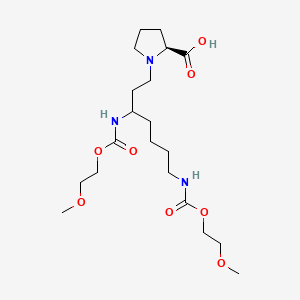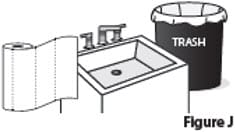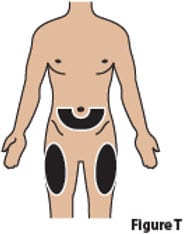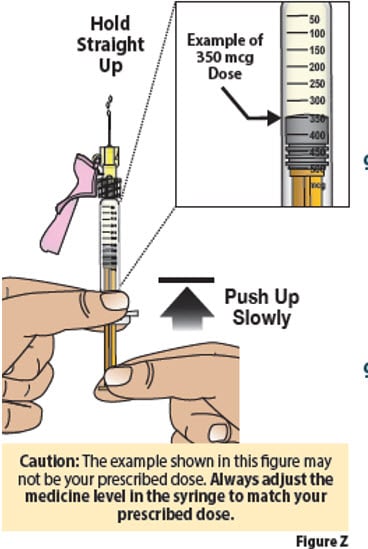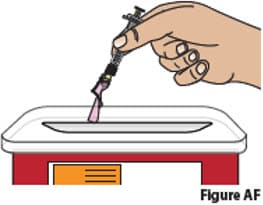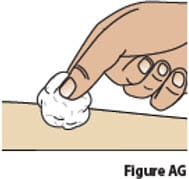Besremi
Generic Name: ropeginterferon alfa-2b-njft
Dosage Form: injection, for subcutaneous use
What is Besremi?
Besremi is a prescription medicine that is used to treat adults with polycythemia vera.
It is not known if Besremi is safe and effective in children.
Besremi Description
Besremi (Ropeginterferon alfa-2b-njft), an interferon alfa-2b, is an N-terminal monopegylated covalent conjugate of proline interferon alfa-2b, produced in Escherichia coli cells by recombinant DNA technology, with a methoxy polyethylene glycol (mPEG) moiety. Ropeginterferon alfa-2b-njft has an approximate molecular weight of 60 kDa and the approximate molecular weight of the PEG portion of the molecule is 40 kDa.
Besremi (ropeginterferon alfa-2b-njft) injection is a sterile, preservative-free, clear and colorless to slightly yellowish solution for subcutaneous use supplied in a single dose prefilled syringe.
Each prefilled syringe delivers 1 mL of solution containing 500 mcg of ropeginterferon alfa-2b-njft and benzyl alcohol (10 mg), glacial acetic acid (0.05 mg), polysorbate 80 (0.05 mg), sodium acetate (1.58 mg), sodium chloride (8 mg), and Water for Injection, USP. The pH is approximately 6.
What is the most important information I should know about Besremi?
Besremi can cause serious side effects that:
- may cause death, or
- may worsen certain serious diseases that you may already have
Tell your healthcare provider right away if you have any of the symptoms listed below during treatment with Besremi. If symptoms get worse, or become severe and continue, your healthcare provider may tell you to stop taking Besremi permanently. These symptoms may go away in some people after they stop taking Besremi. Mental health problems, including suicide. Besremi may cause you to develop mood or behavior problems that may get worse during treatment with Besremi or after your last dose, including:
- irritability (getting upset easily)
- restlessness and agitation
- confusion
- depression (feeling low, feeling bad about yourself or feeling hopeless)
- unusually grand ideas
- acting aggressive
- acting impulsively
- thoughts of hurting yourself or others, or thoughts of suicide
If you develop any of these symptoms, stop using Besremi right away. You, your caregiver, or family member should call your healthcare provider right away. Your healthcare provider should carefully monitor you during treatment with Besremi.
New or worsening autoimmune problems. Besremi may cause autoimmune problems (a condition where the body’s immune cells attack other cells or organs in the body), including thyroid problems, increased blood sugar (hyperglycemia), and type I diabetes. In some people who already have an autoimmune problem, it may get worse during your treatment with Besremi. Tell your healthcare provider if you have any of the following symptoms: tiredness, urinating often, or if you are very thirsty.
Heart problems. Besremi may cause heart problems, including problems with your heart muscle (cardiomyopathy), heart attack, abnormal heart rhythm (atrial fibrillation), and decreased blood flow to your heart. You should not use Besremi if you: have high blood pressure that is not controlled, congestive heart failure, a serious abnormal heart rhythm, narrowing of the arteries to your heart, certain types of chest pain (angina), or a recent stroke or heart attack.¶
If you have a heart problem before you start using Besremi, your healthcare provider should monitor you closely during treatment with Besremi.
Call your healthcare provider right away if you get any of the symptoms listed above during treatment with Besremi. Before and during treatment with Besremi you will need to see your healthcare provider regularly and have blood tests to monitor your polycythemia vera, and to check for side effects. Besremi can cause serious side effects. Some of these side effects may cause death. Tell your healthcare provider right away if you have any of the symptoms listed above during treatment with Besremi. For more information about side effects, see “What are the possible side effects of Besremi?”
Who should not use Besremi?

Do not use Besremi if you:
- have or had severe mental health problems, especially severe depression, thoughts of suicide, or attempted suicide
- have or had a serious or untreated autoimmune disease
- have had a serious allergic reaction to another interferon product or to any of the ingredients in Besremi. Symptoms of a serious allergic reaction to alpha-interferon may include itching, swelling of your face, tongue, throat, trouble breathing, feeling dizzy or faint, and chest pain. See the end of this Medication Guide for a complete list of ingredients in Besremi. Ask your healthcare provider if you are not sure.
- have certain types of liver problems
- have received a transplant and take immunosuppressive medicines
Talk to your healthcare provider before taking Besremi if you have any of these conditions.
What should I tell my healthcare provider before using Besremi?
Before using Besremi, tell your healthcare provider about all of your medical conditions, including if you:
- are being treated for a mental illness or had treatment in the past for any mental illness, including depression and have had thoughts of hurting yourself or others.
- have type 1 diabetes
- have or ever had any problems with your heart, including heart attack or high blood pressure
- have or ever had bleeding problems or a blood clot
- have or ever had low blood cell counts
- have a condition that suppresses your immune system, such as certain cancers
- have hepatitis B infection
- have HIV infection
- have kidney problems
- have liver problems
- are pregnant or plan to become pregnant. Besremi may harm your unborn baby and may cause loss of your pregnancy (miscarriage).
- Before you start using Besremi your healthcare provider should do a pregnancy test.
- You should use effective birth control during treatment and for at least 8 weeks after your final dose of Besremi. Talk to your healthcare provider about birth control choices for you during treatment with Besremi.
- Besremi can affect your menstrual cycles and may cause your menstrual periods to stop.
- Tell your healthcare provider if you become pregnant during treatment with Besremi.
- are breastfeeding or plan to breastfeed. It is not known if Besremi passes into your breast milk. You should not breastfeed during treatment and for 8 weeks after your final dose of Besremi.
Tell your healthcare provider about all the medicines you take, including prescription and over-the-counter medicines, vitamins, and herbal supplements.
Besremi and certain other medicines may affect each other and cause side effects. Know the medicines you take. Keep a list of your medicines and show it to your healthcare provider and pharmacist when you get a new medicine.
How should I use Besremi?
- See the Instructions for use that comes with Besremi for detailed instructions on how to prepare and inject a dose of Besremi.
- Use Besremi exactly as your healthcare provider tells you to. Your healthcare provider will tell you how much Besremi to inject and when to inject it. Do not inject more than your prescribed dose.
- Besremi is given as an injection under your skin (subcutaneous injection). Your healthcare provider should show you how to prepare and measure your dose of Besremi, and how to inject yourself before you use Besremi for the first time.
- You should not inject Besremi until your healthcare provider has shown you how to use Besremi the right way. Your healthcare provider will prescribe the amount of Besremi that is right for you.
- Do not inject more than 1 dose of Besremi every 2 weeks without talking to your healthcare provider. Do not re-use the single-dose prefilled syringe.
- Your healthcare provider should do blood tests before you start Besremi, and regularly during treatment to monitor your polycythemia vera, and to check you for side effects.
What should I avoid while using Besremi?
- Besremi may cause neurologic symptoms including dizziness, sleepiness, and hallucinations. Avoid driving or using machinery if you develop any of these neurologic symptoms during treatment with Besremi.
What are the possible side effects of Besremi?
Besremi can cause serious side effects including:
- See “What is the most important information I should know about Besremi?”
- Decreased blood cell counts. Decreased blood cell counts are common with Besremi and can sometimes also be severe, especially decreased platelets or white blood cells. Your red blood cells may also be decreased. Your healthcare provider should check your blood cell counts before you start and during treatment with Besremi. If your blood cell counts are low you can develop anemia, infections or have problems with bleeding or bruising.Call your healthcare provider right away if you develop any of the following symptoms:
- weakness and tiredness
- bruising easily
- you have nose bleeds often
- fever
- chills
- burning and painful urination
- urinating often
- coughing up yellow or pink mucus (phlegm)
- Serious allergic reactions and skin reactions. Besremi can cause serious, sudden allergic reactions.Get medical help right away if you get any of the following symptoms:
- skin rash or hives
- itching swelling of your face, eyes, lips tongue, or throat
- trouble breathing
- chest pain
- feeling faint
- Eye problems. Besremi can cause severe eye problems with your retinas that can lead to vision loss or blindness. You should have an eye exam before and during treatment with Besremi if you have diabetes or high blood pressure and also have retinal problems. Your healthcare provider may stop Besremi if you develop new or worse eye problems during treatment with Besremi.
- Liver problems. Besremi can cause increases in liver enzymes and liver damage. Your healthcare provider should do blood tests to monitor your liver enzymes and liver function before you start and during treatment with Besremi.
- Kidney problems. Your healthcare provider will do blood tests to check your kidney function before starting and during treatment with Besremi. Tell your healthcare provider right away if you develop any symptoms of a kidney problem, including:
- changes in the amount or color of your urine
- blood in your urine
- swelling in your ankles
- loss of appetiteYour healthcare provider may stop Besremi if you develop severe kidney problems.
- Tooth and gum (periodontal) problems. Besremi can cause tooth and gum problems which can lead to tooth loss. Besremi can also cause problems with dry mouth that can damage your teeth and the lining of the mouth during long-term treatment with Besremi. It is important for you to brush your teeth well, two times each day and have regular dental examinations during treatment with Besremi.
- Skin problems. Besremi can cause skin problems. Signs and symptoms of a skin problem with Besremi include:
- itching
- hair loss
- rash
- redness
- psoriasis
- acne
- thickening of the skin
- excessive sweatingCall your healthcare provider if you develop a rash that is bothersome or covers a large skin area.
The most common side effects of Besremi include:
- flu like symptoms including: tiredness, weakness, fever, chills, muscle aches, and joint pain
- itching
- sore throat.
These are not all of the possible side effects of Besremi.
Call your doctor for medical advice about side effects. You may report side effects to FDA at 1-800-FDA-1088.
General information about the safe and effective use of Besremi
Medicines are sometimes prescribed for purposes other than those listed in a Medication Guide. Do not use Besremi for a condition for which it has not been prescribed. Do not give Besremi to other people, even if they have the same symptoms that you have. It may harm them. You can ask your pharmacist or healthcare provider for information about Besremi that is written for health professionals.
How should I store Besremi?
- Store Besremi in the refrigerator between 36° F to 46° F (2° C to 8° C).
- Keep Besremi away from heat.
- Do not freeze Besremi.
- Keep the Besremi pre-filled syringe in the outer carton to protect it from light.
Keep Besremi and all medicines out of the reach of children.
What are the ingredients in Besremi?
Active ingredient: ropeginterferon alfa-2b-njft
Inactive ingredients: benzyl alcohol, glacial acetic acid, polysorbate 80, sodium acetate, sodium chloride, Water for Injection.
For more information, go to www.BESREMi.com or call 1-800-999-2449
Instructions for use for Besremi
Besremi [bez-reh-me]
(ropeginterferon alfa-2b-njft)
injection, for subcutaneous use
Single-dose prefilled syringe
This “Instructions for Use” contains information on how to prepare and inject Besremi under your skin (subcutaneous injection) using the single-dose prefilled syringe.
Guide to Prefilled syringe and Needle Parts (Figure A)
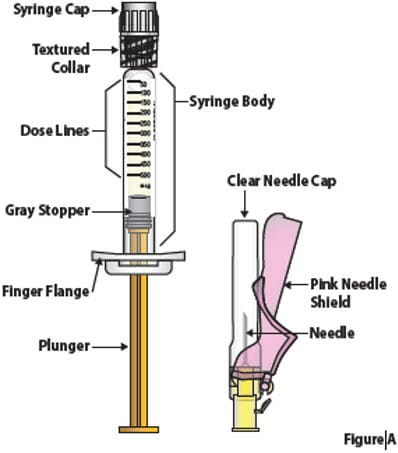
Storing Besremi
Store the Besremi carton in the refrigerator between 36°F to 46°F (2°C to 8°C) (Figure B).
- Keep your Besremi prefilled syringes in their original carton (Figure B) while stored.
- Do not freeze the prefilled syringes.
- Do not use a prefilled syringe that has been frozen or left in direct sunlight.
- Keep Besremi prefilled syringes, needles, and all medicines out of the reach of children.

Important information you need to know before injecting Besremi
Read this Instructions for Use before using your single-dose Besremi prefilled syringe for the first time and each time you get a new prescription. There may be new information. This leaflet does not take the place of talking with your healthcare provider about your medical condition or your treatment. Ask your healthcare provider about the right way to prepare and give your Besremi injection.
- Your healthcare provider will tell you the prescribed dose that you should take and the right amount of Besremi to measure in the prefilled syringe for your dose. Each time you inject, be sure that you know the prescribed dose of Besremi to inject. Your dose may change over time.
- Besremi is for subcutaneous (under the skin) injection only.
- Besremi is for one-time use only. Do not reuse your prefilled syringe or needle.
- Do not use a prefilled syringe or needle that is damaged or broken. Contact your healthcare provider for a replacement prefilled syringe or additional needles.
- Inject Besremi into the top of the thighs or lower stomach-area just under the skin. Do not inject Besremi into any other area of the body.
- Throw away (dispose of) the Besremi prefilled syringe with needle attached right away after use, even if there is medicine left in the prefilled syringe. See Step 10 in the section “Dispose of used prefilled syringes and needles.”
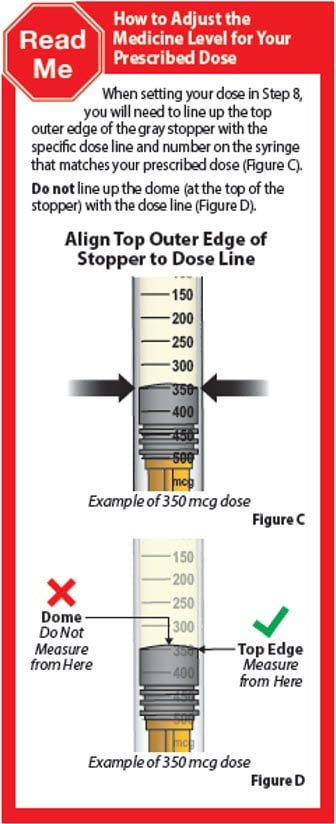
| Gather and check supplies | |||
| 1. | Prepare Besremi Prefilled Syringe | ||
| 1.1. | Take the Besremi carton out of the refrigerator (Figure E).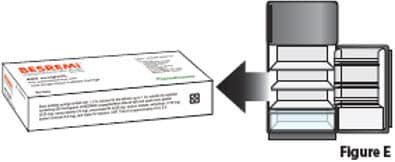 |
||
| 1.2. | Check the expiration date (“EXP”) on the top panel of the carton to make sure it has not passed (Figure F). Do not use the prefilled syringe if the expiration date has passed. 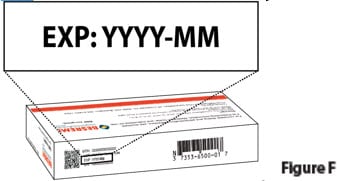 |
||
| 1.3. | Let carton containing the Besremi prefilled syringe sit on a clean work surface for 15 to 30 minutes to allow it to come to room temperature (Figure G). Do not warm the prefilled syringe any other way. |
||
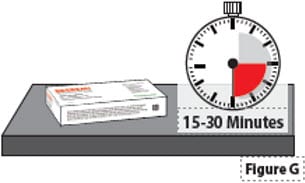 |
|||
| 2. | Gather supplies for injection | ||
| 2.1. | After allowing the prefilled syringe to come to room temperature for 15 to 30 minutes inside the carton, gather the following additional supplies. Alcohol Swab (Figure H).  FDA-cleared Sharps Disposal Container (Figure I) FDA-cleared Sharps Disposal Container (Figure I)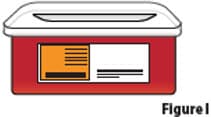
A paper towel, sink, or trash can to minimize mess during dose adjustment (Figure J). Optional Items: Gauze or Cotton Ball and a Small Adhesive Bandage (Figure K). |
||
| 3. | Wash hands and remove syringe from tray | ||
| 3.1. | Wash your hands with soap and water, then dry your hands (Figure L). |
||
| 3.2. | Open the carton and remove the clear plastic tray that holds the Besremi prefilled syringe and needle package (Figure M).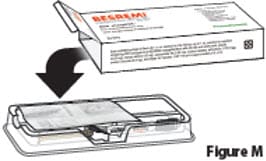 |
||
| 3.3. | Remove the needle package and Besremi prefilled syringe from the plastic tray. Hold the prefilled syringe by the middle of the syringe body during removal (Figure N).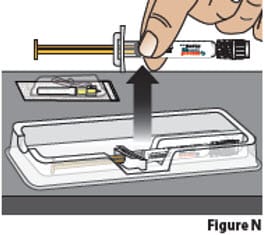 |
||
| 4. | Check the liquid medicine in the Besremi prefilled syringe | ||
| 4.1. | Check the liquid medicine in the prefilled syringe (Figure O). The liquid should be clear and colorless to slightly yellow, and should not have particles. Do not use the prefilled syringe if the liquid is cloudy, discolored, or contains particles. Contact your healthcare provider or pharmacist. |
||
| 4.2. | Check the syringe to see if it is damaged or broken (Figure O). Do not use if it shows any signs of damage or breakage. Contact your healthcare provider or pharmacist. 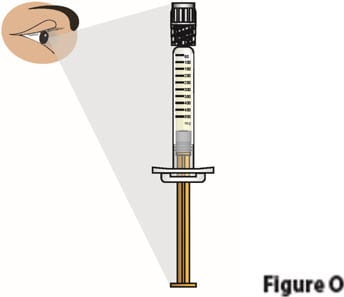 |
||
| Prepare syringe for injection | |||
| 5. | Attach the needle to the Besremi prefilled syringe | ||
| 5.1. | Carefully open the needle package, remove the needle, and set it aside (Figure P). Throw away the packaging into household trash. 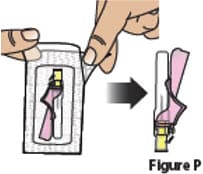 |
||
| 5.2. | Hold the prefilled syringe as shown. Remove the prefilled syringe cap by unscrewing it counter-clockwise (Figure Q). Throw away the syringe cap into household trash. Do not allow the tip of the prefilled syringe to touch anything. 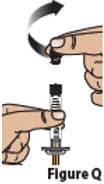 |
||
| 5.3. | Attach the needle to the prefilled syringe by firmly pushing it into the collar of the syringe and then screwing (turn clock-wise) it on until it feels securely attached (Figure R).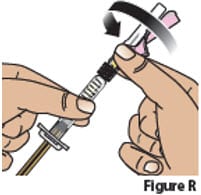
The needle should now be assembled to the prefilled syringe (Figure S). |
||
| 6. | Choose and clean injection site | ||
| 6.1. | Choose one of the following injection sites (Figure T):
|
||
| 6.2. | Clean the chosen injection site with an alcohol swab and let it air dry (Figure U). Do not blow on or touch the injection site after it has been cleaned. 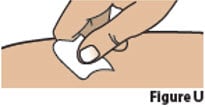 |
||
| 7. | Uncap needle and move air bubbles to top | ||
| 7.1. | Pull the pink needle shield back (Figure V). Note: The pink needle shield will be used after the injection to cover the needle and protect you from needle-stick injuries. 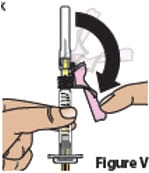 |
||
| 7.2. | Hold the syringe from the syringe body. Remove the clear needle cap by pulling it straight off (Figure W). Throw away the needle cap into household trash. Do not recap needle. 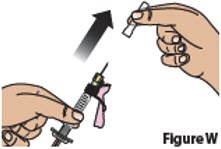 |
||
| 7.3. | Hold the prefilled syringe with the needle pointing up. Tap on the body of the prefilled syringe to move any air bubbles to the top (Figure X). 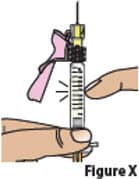 |
||
| 8. | Set your dose | ||
| 8.1. | Check your prescription to identify your prescribed dose (Figure Y). Depending on your prescribed dose, you may have to adjust the dose in the syringe by getting rid of (discarding) some medicine from the prefilled syringe before you inject the medicine.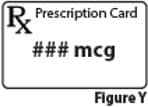 |
||
| 8.2. | To set your dose follow the 4 steps below:1. Hold the prefilled syringe at eye level with the needle pointing straight up over a paper towel, sink, or trash can.
2. Check that you can see the dose lines and number markings on the prefilled syringe. 3. Pinch the end of the plunger as shown (Figure Z). 4. Slowly push up on the plunger to remove liquid medicine until the top edge of the gray stopper lines up with the marking for your prescribed dose (Figure Z). Keep holding straight up as you set the dose. Important: If you accidentally remove too much liquid medicine, do not inject. Contact your healthcare provider or pharmacist.
|
||
| Inject Besremi | |||
| 9. | Give Injection | ||
| 9.1. | Pinch the chosen injection site (Figure AA). |
||
| 9.2. | While pinching the skin, insert the needle at a 45 to 90 degree angle into the pinched skin (Figure AB). Then release the pinched skin. 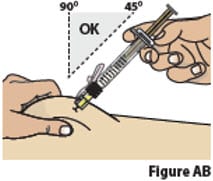 |
||
| 9.3. | Inject the medicine by slowly pressing down on the plunger all the way until it stops (Figure AC).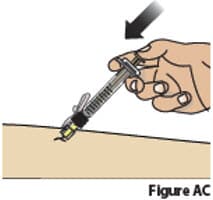 |
||
| 9.4. | After all the liquid medicine is injected, remove the needle from the skin (Figure AD).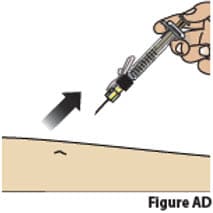 |
||
| 9.5 | Cover needle Carefully push the pink needle shield over the needle until it snaps into place and covers the needle (Figure AE). This helps prevent needle-stick injuries. Do not recap the needle using the needle cap. Only use the pink needle shield to cover the needle. |
||
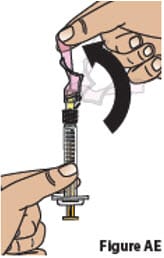 |
|||
| Do not reuse the prefilled syringe and needle. | |||
| Disposing of used prefilled syringes and needles | |||
| 10. | Dispose of used prefilled syringes and needles.
|
||
| 11 | Check injection site. | ||
| 11.1 | If there is a small amount of blood or liquid at the injection site, press a gauze or cotton ball over the injection site until the bleeding stops (Figure AG). | ||
| 11.2 | Do not rub the injection site. If needed, you may apply a small adhesive bandage.
|
||
Source: NLM

